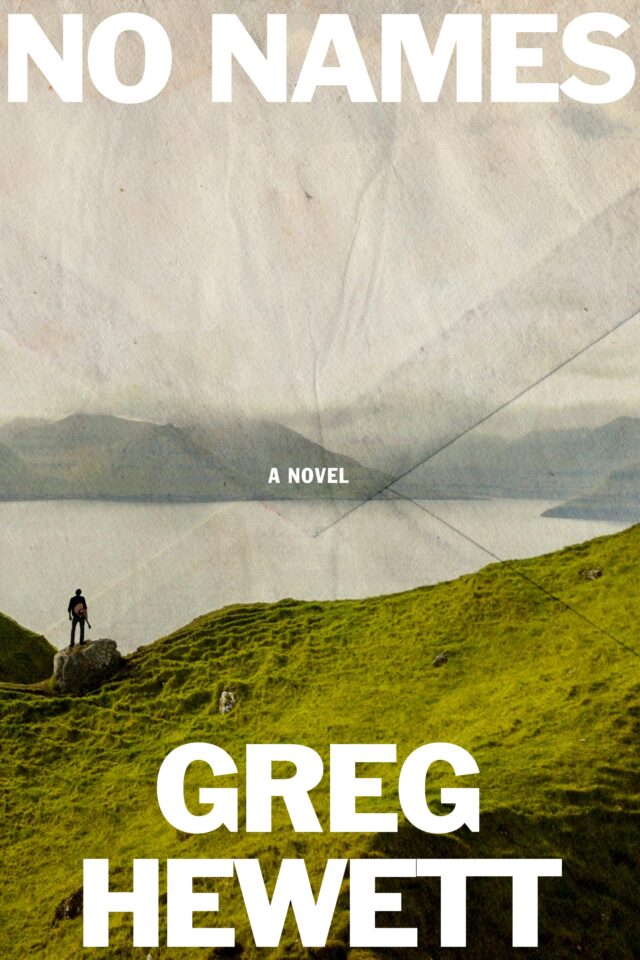
Greg Hewett’s new novel No Names is part encomium to punk, part collection of love stories and part exploration of how music creates intimate connections for both listeners and musicians. Alternating between multiple narrators and time periods, the novel jumps back and forth in time through the seventies, nineties and the 2010s. But the brilliance of this novel isn’t just in how it demonstrates the connections between art and identity; or in its exploration of how that influences relationships between family, friends, and lovers over generations. Greg Hewett has written an unapologetic display of human nature, allowing for a moral ambiguity in expressions of love between people as well as that of music and artistic creation. Naturally it shows love’s power to heal, but also its destructive potential—and the novel refuses to separate the two.
Mike, the central character, leads a punk band called the No Names which “blazed across the music scene for maybe nine months, back in ‘78” and then, comet-like, disappeared. Self-effacing and emotionally avoidant, Mike’s exactly the kind of musician that teenage (and adult) fans obsess over. Two other narrators in the novel, Daniel and Issac, are no exception. Everyone is looking for the real Mike, trying to find him beneath his dark layers of trauma, to understand him, his music, his past, his soul—and, of course, to have sex with him. In typical punk fashion, those connections are exactly what Mike instinctively runs from.
Mike is the narrator in the majority of the sections set in the seventies, telling the story of his youth in the industrial town of Hallein, meeting Pete Lac, their intense friendship, and how they started the band called the No Names. But this isn’t just a punk coming-of-age piece; it’s a story about soulmates. Pete and Mike are each other’s muse, each other’s guide and foil. And as their friendship grows, an unambiguous sexual tension arises, one Mike both recognizes and ignores as many young queer men in the 70s would. During a party by the river with “a keg, some weed, a bonfire” couples start disappearing into the thicket, and Mike runs into Pete having sex with “[o]ne of those rich girls…[m]aybe called Jill or Kim?”
I’m getting hard and feeling sick all at the same time. I stand there, stock-still, yet somehow Pete senses me and turns his head around. He flashes those black-diamond eyes of his at me while continuing to drill away. He then gives me a weird kind of grin. I can tell I’m supposed to give a thumbs-up, so I do. Like an idiot, I do. He turns back to this girl and at the same time reaches behind for my hand.
Pete ignores Mike’s discomforts with uninhibited audacity and demands an intimacy that is troubling, problematic, and also a beautifully honest portrayal of a queer love story in the 70s.
The physical and the emotional always stand alongside each other in their interactions. Later, after everyone has left the party, Mike and Pete stay by the river and have one of those meandering conversations anyone who was ever an angst-filled teenager will recognize. Then they arrive at the sensitive subject of Mike’s brother who died in the Vietnam war.
I’m not looking in [Pete’s] direction but sense his face moving in closer to mine. “You’ve never told me about him,” he whispers, “about what happened.”
Truth is, I’ve never talked to anyone about John. Never wanted to. Now, for the first time, I do, or at least I think I do. Except words feel impossible in my head, let alone my mouth.
Hewett does a wonderful job dramatizing personal barriers to self-expression—emotional and intellectual. That is Mike’s constant struggle. His instinct closes him off from expression. But when others bring it out of him, it’s the stuff that art is made of. Not long after this scene, they create their band.
But interwoven into this 70s artist’s journey is one set in the 90s where Mike is living like a hermit on a remote spot in the already-remote Faroe Islands. Now his only friend, Daniel, sends him a letter he received from a young No Names fan, Issac, hoping it will make him want to rejoin the world. We don’t know where Pete is. But it’s clear that, without him, it’s much more difficult to bring Mike out of his self-imposed solitude. And Daniel and Issac are an unlikely duo.
Issac is a teenager from Mike’s hometown. His chapters are swollen with youthful exuberance for punk music as well as the insecurity and arrogance of a privileged high-school graduate. This is on full display as he’s shifting through his mother’s old record collection.
I guess I’m supposed to go, like, Look at all this crazy ’70s shit, and think it’s kitschy-hip, but I don’t. It’s just plain sad… I ought to haul the whole lot down to Rongo at the Vinyl Heart and get a few bucks or some weed for them.
His contemptuous tone smacks less of conviction and more of someone trying to convince themselves they’re better than their parents. It’s insufferable, but also honest. Any readers for whom Issac holds up a mirror to their own unbearably earnest teenage years will find themselves blushing and laughing at themselves as much as at him.
Still, a sophomoric voice like Issac’s needs a counterbalance for harmony’s sake. Daniel’s is so markedly different that it’s hard to believe it was written by the same writer. For example take his description of a night spent talking to Issac in Hallein’s salt mines—a place they both know was important to Mike’s childhood.
Now dawn advances into the abstract space with precision, with momentousness. It’s as if it were a neolithic site for some astronomically based ritual, the significance of which is now lost, and not simply an abandoned mine. The darkness turns star-white. Walls, ceiling, floor all shimmer like an epiphany I cannot discern the meaning of.
Daniel’s narrative has the philosophical airs of a classicist, the rhythm of a concerto along with an inscrutable Nordic cool that’s both intriguing and unsettling. Interestingly, Daniel and Issac seem to personify two major parts of Pete’s personality: the sensitive philosopher and the aimless rebel.
No Names is a spiraling narrative about seeking out music, music which molds both its creators’ and its listeners’ histories; it’s a confused love story that doesn’t ignore homophobia, but also doesn’t rehash tropes of gay angst and self-hatred that typify so many queer stories of the 70s. With all this in mind, it seems natural that the music unifying the characters is punk, a style that instinctively rejects arbitrary social pressures. Yes, there are bigots in punk too. But the genre has always been liberating for outsiders, not just attracting queer fans and artists, but creating a space where its fans see conformity as the enemy and non-conformity as something to celebrate. This is music that’s anti-establishment, anti-mainstream, screaming righteous anger while ripping open its chest and hurling its tender heart directly at your gobsmacked face. No Names captures that esthetic beautifully in the friendships, musical partnership and love that we see between Mike, Pete, Issac, and Daniel. It’s messy. But they’re messy. Their voices harmonize into a gorgeous, poetic mess that if you don’t wish you could experience yourself then I question the state of your soul. In other words—Read it, punk.
Publisher: Coffee House Press
Publication Date: April 8, 2025
Reviewed by David Lewis
David Lewis’s reviews and fiction have appeared or are forthcoming in The Los Angeles Review of Books, Joyland, Barrelhouse, Strange Horizons, The Weird Fiction Review, Ancillary Review of Books, 21st Century Ghost Stories Volume II, The Fish Anthology, Willesden Herald: New Short Stories 9, The Fairlight Book of Short Stories, Paris Lit Up and others. Originally from Oklahoma, he now lives in France with his husband and dog.
